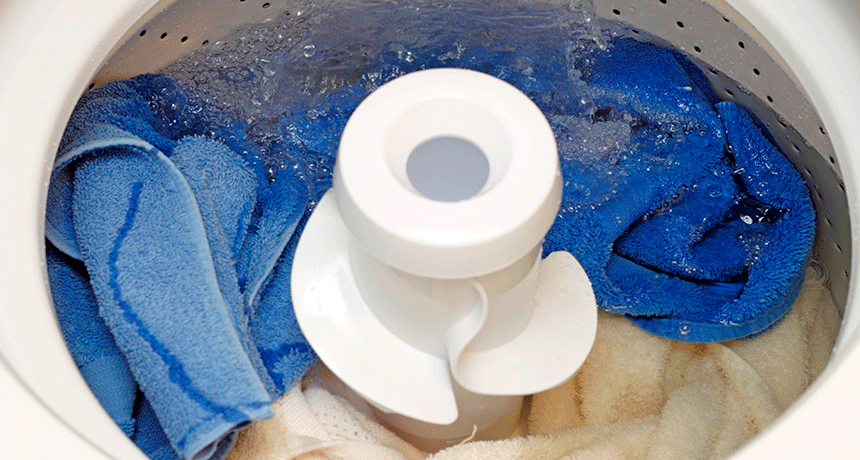Chemists look to mine silver from laundry wastewater
Laundering can release the toxic metal, which often is added to fabrics to retard bacterial growth

Laundered fabrics have become a notable source of silver, which can be lost to the environment. Now chemists are working to retrieve that precious metal from wash water.
Serenethos/iStockphoto
Believe it or not, laundry wash water can hold a mother lode of silver. And scientists are looking for ways to recover this precious metal. Their main goal is not to make big bucks selling it to people who make jewelry, coins or pricey flatware. Silver is toxic. So researchers want to catch it before it threatens wildlife. Now, two environmental engineers report preliminary success doing just that.
They have developed a way to extract silver from wash water. If the technique proves affordable and reliable, that silver could be recycled for a host of uses. The researchers have just shared their innovation in the January 2 ACS Sustainable Chemistry & Engineering.
For years, companies have added nano-sized bits of silver to all types of products — especially fabrics. Their main aim has been to fight the growth of odor-causing bacteria. That’s why this treatment has been especially popular for athletic wear, such as socks.
Studies soon showed, however, that nanosilver doesn’t stay put. It soon starts washing away in the laundry. Because that wash water ultimately makes its way into rivers, lakes and the ocean, so can the silver. And that could pose risks to wildlife.

“[Researchers] are walking a fine line between silver’s desirable properties and its potential toxicity to the environment,” argues science journalist Silke Schmidt. “Products embedded with nano-silver,” she notes, “tend to lose some of their silver coating every time they’re laundered.”
And stinky germs are not the only things that metal can poison. “Silver is harmful to humans, rats and aquatic species such as zebrafish and rainbow trout,” notes Tabish Nawaz. He’s an environmental engineer who works at the University of Massachusetts in Dartmouth. That same silver also can harm the growth of aquatic embryos, he notes, such as those of developing fish.
To protect all these creatures, he says, that silver needs to be removed from the laundry water before it spills out of a community’s waste-treatment plant. With that in mind, Nawaz teamed up with Sukalyan Sengupta, also at the University of Massachusetts. Together they are fine-tuning a technique to mine that nuisance silver from the laundry.
The trick: Turn to chemistry
Ions are electrically charged atoms or molecules. This means they’re missing electrons (making them positively charged) or have extra electrons (making them negatively charged). In the wash water, silver atoms exist as ions. These ions are positively charged.
Nawaz and Sengupta’s trick for harvesting silver is to trap those silver ions in a special type of resin. It, too, contains ions. That resin is made into beads and then packed into cylinders known as columns. Liquids, such as wash water, then get pumped through the columns.
When the liquid contacts the resin, something interesting happens. Ions in the liquid start swapping places with ions in the resin. As some ions are trapped, others are released. This process is known as ion exchange. (That’s why the resin is known as an ion-exchange resin.)
The idea is simple. Making it work, however, can be challenging.
The problem is that silver is not the only positive ion in the wash water. Laundry detergent, Nawaz points out, contains other types of positive ions, such as sodium ions. Any of these might bind to the resin in place of the silver.
What’s more, he notes, “several other detergent components react with silver.” They can do this through a range of other processes (known as complexation, precipitation, oxidation or reduction). The result? Those processes may make the silver unavailable to the resin.
But his team was able to overcome the challenge. How? Different ion-exchange resins contain different “functional groups.” These are particular group of atoms that perform particular roles in chemical reactions. Nawaz says that he and Sengupta used an ion-exchange resin with a functional group that targets silver. The functional group they chose is known as a thiol (THY-all).
To up their resin’s performance, the engineers did not just add thiol. They also changed some other conditions (such as pH and temperature). Afterward, they were able to trap and remove 84 percent of the silver that had been added to water in the lab.
But how much silver can wash water deliver? After crunching a few numbers, Nawaz estimates that it could run to “about 2 grams [0.07 ounce] per person per day.” Multiply that by the population of the United States, for instance, and you’ll find that’s an estimated 652,000 kilograms (1,437,414 pounds) of silver!
Recovering that much before it enters the environment would be much better for wildlife than trying to catch it later.
Some doubts remain
Denise Mitrano is a geochemist in Dubendorf, Switzerland. She works at the Swiss Federal Institute of Aquatic Science and Technology. There, she studies how to measure nanopollutants in the environment. Mitrano questions whether it’s even necessary to trap silver from wash water. Many big cities run wastewater-treatment facilities. Their role is to clean up a community’s dirty water. And in many of those plants, she argues, “silver is effectively diverted to the sewage sludge.” That’s a special goopy type of waste separated from the water.
Silver may sit trapped in that sludge, Mitrano says. And that could prevent large amounts of it from getting into the environment.
Cost is another issue to consider, she notes. Just because it’s possible to do something does not mean it can be done affordably or conveniently. Those are big issues here, she says. For instance, she asks, would the benefits of ion-exchange trapping outweigh the potential cost to the environment (and launderers) of letting this silver continue to wash away?
Those are questions engineers will have to explore. For now, Nawaz would like to see people play a bigger role in managing the wastes they release. “To be successful, effective waste management requires that everyone get on board,” he says. “We also need to inform people just how much our choices are affecting the environment.”
But if society is successful in getting rid of this toxic metal from waste water, the only question left may be what to do with all that silver.







